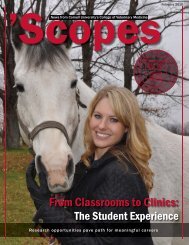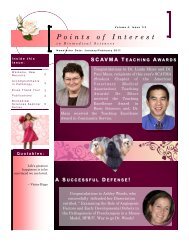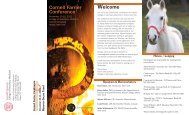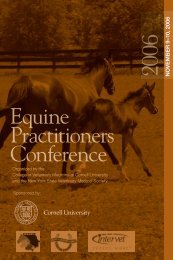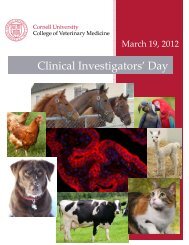2010 (PDF) - The College of Veterinary Medicine at Cornell University
2010 (PDF) - The College of Veterinary Medicine at Cornell University
2010 (PDF) - The College of Veterinary Medicine at Cornell University
You also want an ePaper? Increase the reach of your titles
YUMPU automatically turns print PDFs into web optimized ePapers that Google loves.
Program Scholars<br />
& their Research<br />
Emily Ames, <strong>University</strong> <strong>of</strong> Calgary, Reproductive Biology<br />
Characteriz<strong>at</strong>ion <strong>of</strong> MATER Expression in Feline Oocytes<br />
I applied to the Leadership Program while in my second year <strong>at</strong> UCVM in<br />
order to broaden my understanding <strong>of</strong> non-traditional careers available to<br />
veterinarians. I have been involved in veterinary clinical practice from a<br />
young age and still gre<strong>at</strong>ly enjoy it. However, I have increasingly become<br />
fascin<strong>at</strong>ed by the how’s and why’s <strong>of</strong> the process, diagnosis and tre<strong>at</strong>ment<br />
<strong>of</strong> animal diseases and production challenges. My experiences this summer<br />
have truly opened my eyes to the numerous ways I can expand on these<br />
interests throughout my career while contributing directly or indirectly to<br />
clinical practice. I am considering the numerous options available to me after<br />
gradu<strong>at</strong>ion with enthusiasm and will likely pursue an internship as a fi rst step<br />
toward my career goal.<br />
My summer research project was focused on the study <strong>of</strong> MATER in feline<br />
oocytes. MATER or M<strong>at</strong>ernal Antigen Th<strong>at</strong> Embryos Require is a m<strong>at</strong>ernal<br />
effect gene with an expression th<strong>at</strong> is thought to be restricted to oocytes<br />
and early embryos. It was fi rst identifi ed as an antigen associ<strong>at</strong>ed with a mouse model <strong>of</strong> autoimmune oophoritis<br />
resulting in permanent sterility. <strong>The</strong> Coonrod lab is studying MATER as a potential immunogen in order to produce a<br />
permanent vaccine immunosterilant for female c<strong>at</strong>s. My project involved characterizing the loc<strong>at</strong>ion <strong>of</strong> MATER DNA<br />
transcription and proteins in feline reproductive tissues and oocytes.<br />
I would like to extend a heartfelt thanks to Dr. Scott Coonrod and all the fantastic people working in his labor<strong>at</strong>ory,<br />
especially Boram Kim. I would also like to thank Drs. McGregor and Fraser for making this program possible and<br />
facilit<strong>at</strong>ing an unforgettable summer.<br />
To prepare tomorrow’s scientists and public health pr<strong>of</strong>essionals<br />
23



